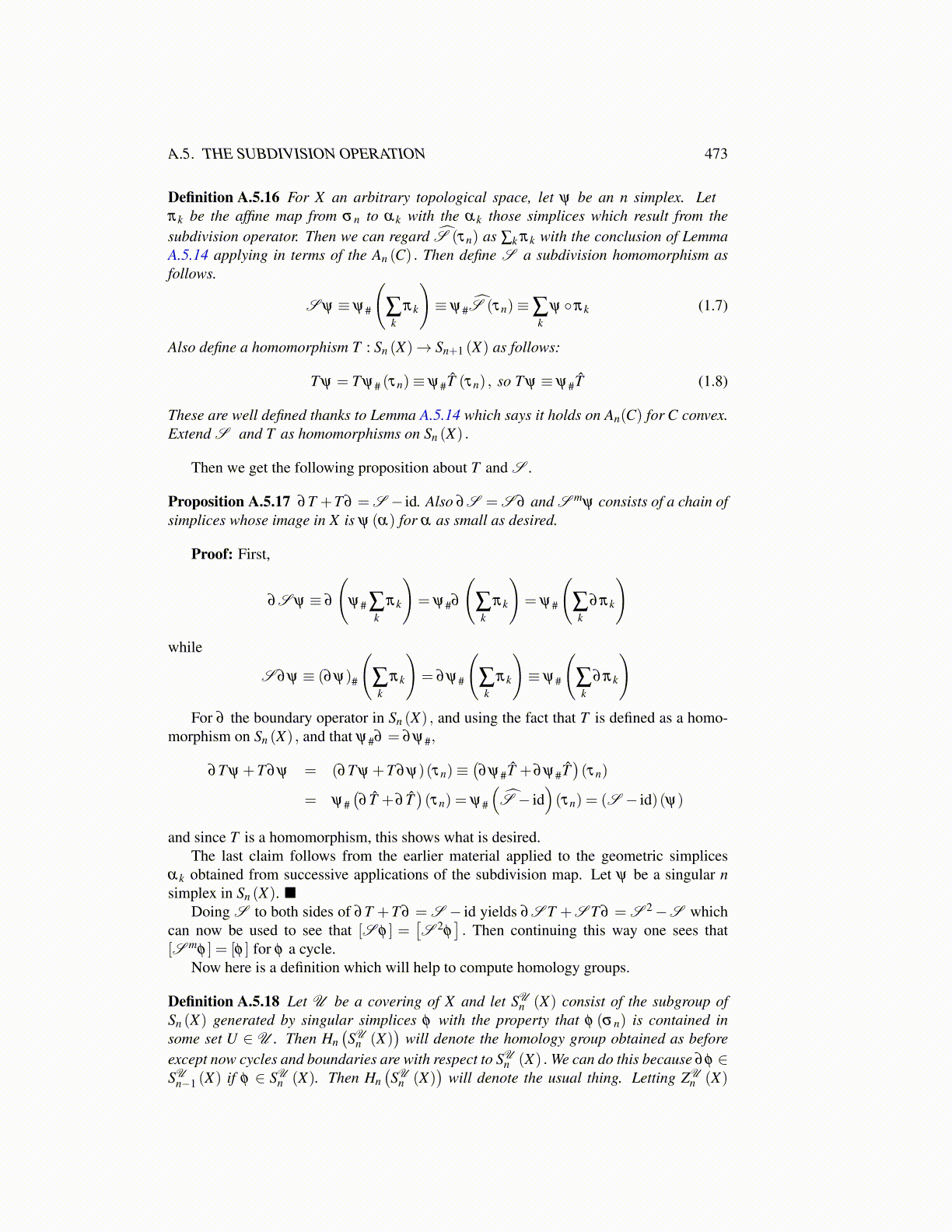
A.5. THE SUBDIVISION OPERATION 473
Definition A.5.16 For X an arbitrary topological space, let ψ be an n simplex. Letπk be the affine map from σn to αk with the αk those simplices which result from thesubdivision operator. Then we can regard Ŝ (τn) as ∑k πk with the conclusion of LemmaA.5.14 applying in terms of the An (C) . Then define S a subdivision homomorphism asfollows.
S ψ ≡ ψ#
(∑k
πk
)≡ ψ#Ŝ (τn)≡∑
kψ ◦πk (1.7)
Also define a homomorphism T : Sn (X)→ Sn+1 (X) as follows:
T ψ = T ψ# (τn)≡ ψ#T̂ (τn) , so T ψ ≡ ψ#T̂ (1.8)
These are well defined thanks to Lemma A.5.14 which says it holds on An(C) for C convex.Extend S and T as homomorphisms on Sn (X) .
Then we get the following proposition about T and S .
Proposition A.5.17 ∂T +T ∂ =S − id. Also ∂S =S ∂ and S mψ consists of a chain ofsimplices whose image in X is ψ (α) for α as small as desired.
Proof: First,
∂S ψ ≡ ∂
(ψ# ∑
kπk
)= ψ#∂
(∑k
πk
)= ψ#
(∑k
∂πk
)
while
S ∂ψ ≡ (∂ψ)#
(∑k
πk
)= ∂ψ#
(∑k
πk
)≡ ψ#
(∑k
∂πk
)For ∂ the boundary operator in Sn (X) , and using the fact that T is defined as a homo-
morphism on Sn (X) , and that ψ#∂ = ∂ψ#,
∂T ψ +T ∂ψ = (∂T ψ +T ∂ψ)(τn)≡(∂ψ#T̂ +∂ψ#T̂
)(τn)
= ψ#(∂ T̂ +∂ T̂
)(τn) = ψ#
(Ŝ − id
)(τn) = (S − id)(ψ)
and since T is a homomorphism, this shows what is desired.The last claim follows from the earlier material applied to the geometric simplices
αk obtained from successive applications of the subdivision map. Let ψ be a singular nsimplex in Sn (X). ■
Doing S to both sides of ∂T +T ∂ = S − id yields ∂S T +S T ∂ = S 2−S whichcan now be used to see that [S φ ] =
[S 2φ
]. Then continuing this way one sees that
[S mφ ] = [φ ] for φ a cycle.Now here is a definition which will help to compute homology groups.
Definition A.5.18 Let U be a covering of X and let SUn (X) consist of the subgroup of
Sn (X) generated by singular simplices φ with the property that φ (σn) is contained insome set U ∈ U . Then Hn
(SU
n (X))
will denote the homology group obtained as beforeexcept now cycles and boundaries are with respect to SU
n (X) . We can do this because ∂φ ∈SU
n−1 (X) if φ ∈ SUn (X). Then Hn
(SU
n (X))
will denote the usual thing. Letting ZUn (X)